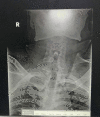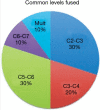A Case Report of Klippel-Feil Syndrome Presenting as Tetraplegia
- PMID: 37529518
- PMCID: PMC10387824
- DOI: 10.7759/cureus.41241
A Case Report of Klippel-Feil Syndrome Presenting as Tetraplegia
Abstract
Cervical spine assessment is an important step in patients who sustained trauma. Klippel-Feil syndrome (KFS) is a complex syndrome with an abnormal fusion of cervical vertebrae at C2 and C3, which is caused by a failure in the division or normal segmentation of the cervical spine vertebrae in early fetal development. This condition leads to a characteristic appearance of a short neck, low hairline, facial asymmetry, and limited neck mobility. People with congenital defects like KFS are more prone to cervical spine injury. KFS is a relatively rare disease. Trivial trauma can lead to neurologic symptoms in such individuals. We present a 32-year-old male, with an alleged history of falls from height with traumatic injury to his head and spine. Following the event, he was unable to move all four limbs. The patient's short neck was noted. Magnetic resonance imaging (MRI) of the spine revealed multilevel fusion of four cervical vertebrae (C3-C7) with a single fused spine which is highly uncommon. Myelopathy secondary to C3-C4 disk protrusion is also seen. The patient was diagnosed with KFS and managed conservatively. The abnormal fusion in KFS predisposes to neurologic injury owing to altered biomechanics of the spine leading to hypermobility of the adjacent normal spine, spondylolisthesis, and stenosis, thereby increasing the likelihood of injuries. Screening and identification of KFS in young children are essential as counseling for lesser strenuous activity might avoid neurological injury and promote better neurological outcomes in the future.
Keywords: cervical vertebrae; paraplegia; screening; spinal trauma; trauma.
Copyright © 2023, Bhavana Chowdary et al.
Conflict of interest statement
The authors have declared that no competing interests exist.
Figures



References
-
- Youmans JR, Winn HR. Philadelphia, PA: Saunders; 2011. Youmans Neurological Surgery.
-
- The prevalence of Klippel-Feil syndrome: a computed tomography-based analysis of 2,917 patients. Gruber J, Saleh A, Bakhsh W, Rubery PT, Mesfin A. Spine Deform. 2018;6:448–453. - PubMed
-
- [Klippel-Feil autosomal dominant syndrome: a malformation of vertebral segmentation] Nauñay VHG, Carvajal IAM. http://dx.doi.org/10.32641/rchped.v90i2.779. Rev Chil Pediatr. 2019;90:194–201. - PubMed
-
- Embriología humana. Valdés A, Pérez H, García R, López A. https://www.academia.edu/14839535/Embriolog%C3%ADa_humana La Habana: Editorial Ciencias Médicas. 2010;8:103–108.
Publication types
LinkOut - more resources
Full Text Sources
Miscellaneous
